11 936-16 – World Meeting of Families (Papal Visit to the U.S.)
This 2015 event was effectively surrounding the very first visit of Pope Francis, to the United States. His trip was a multi-site, multi-event one – culminating in a large outdoor speech in Philadelphia, PA.
From Google Gemini:
Security Measures Surrounding the 2015 World Meeting of Families in Philadelphia and the Visit of Pope Francis
I. Introduction:
The city of Philadelphia hosted the World Meeting of Families in September 2015, a triennial gathering of the Roman Catholic Church recognized as the largest global assembly of Catholic families 1. This event, which drew a record-breaking attendance of over 17,000 pilgrims from more than 100 countries for its Congress portion and approximately 20,000 attendees overall 2, marked a significant occasion for the international Catholic community. The selection of Philadelphia as the host city for this particular meeting held added importance, as it was the first time the event took place in a nation where the majority of the population does not identify as Catholic 4. This unique context amplified the logistical complexities and the potential scope of public interest in the proceedings.
Adding another layer of significance, Pope Francis made a pivotal decision to attend the World Meeting of Families, a commitment that subsequently shaped his six-day tour across three major cities in the United States 5. His visit to North America, spanning from September 19th to 27th, 2015, was intrinsically linked to his participation in the Philadelphia event, scheduled for September 26th and 27th 6. The convergence of such a large-scale international religious conference with the presence of the Pope, a highly prominent global figure and head of state, inherently elevated the security considerations for the event. The symbolic importance of both the World Meeting of Families and the presence of Pope Francis necessitated the implementation of stringent security measures to ensure the safety and well-being of all attendees, the protectee, and the general public. The confluence of these factors created a complex security landscape requiring meticulous planning and a robust, multi-faceted approach from numerous law enforcement and governmental agencies.
II. Overview of the World Meeting of Families and Pope Francis’ Visit to Philadelphia:
The World Meeting of Families in Philadelphia comprised a Congress held from September 22nd to 25th at the Pennsylvania Convention Center 3. This Congress served as the main body of the gathering, featuring discussions, presentations, and activities centered on the theme “Love is our mission: The family fully alive” 2. The overall event culminated with the arrival and participation of Pope Francis on the weekend of September 26th and 27th, 2015 7. This timeline indicates a structured progression, with the Congress providing a foundation leading into the high-profile papal visit, which naturally commanded the highest level of security preparedness.
Pope Francis’ itinerary in Philadelphia on Saturday, September 26th, began with his arrival at Atlantic Aviation at Philadelphia International Airport 6. Following his arrival, he celebrated Mass at the Cathedral Basilica of Saints Peter and Paul 3. Later in the morning, he greeted seminarians at Saint Charles Borromeo Seminary 8. The afternoon saw the Pope deliver a significant address at Independence Hall 3, a location of immense historical and symbolic importance in the United States. The evening of the 26th concluded with his visit to the Festival of Families held on the Benjamin Franklin Parkway 3, a large public event featuring performances and family testimonies.
On Sunday, September 27th, the Pope’s schedule included a morning meeting with bishops at St. Charles Borromeo Seminary 6. Subsequently, he visited with prisoners at the Curran-Fromhold Correctional Facility 6. The culmination of his visit and the World Meeting of Families was the Mass celebrated on the Benjamin Franklin Parkway in the afternoon 3. Before his departure, Pope Francis met with organizers, volunteers, and benefactors at Atlantic Aviation before departing from Philadelphia International Airport 6. The diverse nature of these locations, ranging from enclosed religious sites to iconic historical landmarks and expansive public spaces, each presented unique security challenges that necessitated tailored strategies.
III. Security Designation and Lead Agencies:
Given the high profile of Pope Francis and the scale of the World Meeting of Families, the U.S. Department of Homeland Security (DHS) designated the Pope’s visit as a National Special Security Event (NSSE) 14. This designation is reserved for events of national significance that could be potential targets for terrorism or other criminal activity. The NSSE designation automatically placed the U.S. Secret Service in the lead role for planning, coordinating, and implementing security measures for the entire event 14. The Secret Service’s primary concern was the safety and security of Pope Francis, and the agency possessed the authority to dictate and oversee the necessary security protocols 14.
Recognizing the magnitude of the security undertaking, the Secret Service worked in close collaboration with a multitude of federal, state, and local law enforcement agencies 14. This cooperative effort was crucial, as no single agency possessed the resources or jurisdictional reach to manage all aspects of security for such a large and complex event 15. The partnership involved agencies such as the Philadelphia Police Department, the Pennsylvania State Police, the Federal Bureau of Investigation (FBI), and even the Pennsylvania National Guard 14. To ensure seamless communication and coordination, liaison agents from the FBI were embedded with both local police and the Secret Service 15. Furthermore, officials from approximately 50 different federal, state, and local agencies were involved in the overarching security and public safety efforts, highlighting the extensive interagency cooperation that underpinned the security apparatus 16. This collaborative framework allowed for the pooling of resources, the sharing of intelligence, and the implementation of a unified security strategy across all levels of government.
IV. Comprehensive Security Measures Implemented:
The security measures implemented for the 2015 World Meeting of Families and Pope Francis’ visit were extensive and multi-layered, addressing various potential threats and logistical challenges.
-
A. Perimeter Security: A key component of the security plan involved the establishment of various security perimeters to control access to event venues and surrounding areas. The Secret Service created a secure zone near the Benjamin Franklin Parkway, often referred to as the “Francis Festival grounds” 14. This central area was subject to the strictest security protocols. Outside of this immediate secure zone, a larger area known as the “traffic box,” an approximately two-by-three mile region encompassing much of Center City, was established and manned by the Pennsylvania National Guard and the Philadelphia Police Department 14. This “traffic box” was closed to private vehicles and buses to facilitate pedestrian movement and reduce the risk of vehicle-borne threats 14. Within this “traffic box,” vehicular traffic was permitted to travel and exit, but re-entry was generally not allowed 17. Pedestrians and cyclists, however, were allowed to move freely within the “traffic box” 17. The overall security perimeter for the event extended across much of Center City and was further divided into zones with progressively stricter levels of access control, including areas where driving was prohibited, areas entirely closed to vehicles, designated public screening zones, and event-specific perimeters accessible only to those with the necessary passes 19. Two specific “red zones,” designated as secure perimeters, were established around the Benjamin Franklin Parkway and Independence Hall, featuring fencing and magnetometer entry points to control pedestrian access 20. The area from 12th Street west to 20th Street was designated as a secure perimeter open only to screened pedestrians, with all vehicular traffic prohibited 21. Even within the “Francis Festival grounds,” access was limited, with restrictions on taxis and ride-sharing services during certain hours 21. This layered approach to perimeter security allowed authorities to manage the anticipated large crowds while maintaining a high level of security around the Pope and the main event locations.
-
B. Road Closures and Traffic Restrictions: To manage the expected influx of visitors and create pedestrian-safe zones, extensive road closures and traffic restrictions were implemented throughout Philadelphia. Major highways serving the city, including I-76 eastbound from I-476 to I-95, I-76 westbound from I-95 to US Route 1, I-676 in both directions from I-76 to I-95, and US Route 1 in both directions from US Route 30 to Belmont Avenue, were closed to vehicular traffic 17. The Ben Franklin Bridge, a vital artery connecting Philadelphia and Camden, New Jersey, was also closed to all vehicular traffic, except for emergency vehicles, from Friday evening, September 25th, until Monday noon, September 28th, effectively serving as a pedestrian crossing 12. The “traffic box” in Center City, bordered by Girard Avenue, Delaware Avenue, South Street, and the Schuylkill River, became fully operational with traffic restrictions starting at 6 PM on Friday, September 25th 12. A similar but smaller “traffic box” was also established in West Philadelphia 18. Additionally, specific exit ramps on major highways like I-95 and I-676 leading into the restricted zones were closed 21. These closures were implemented according to a phased timeline, with some restrictions, such as the clearing of designated emergency routes, beginning earlier in the week 21. While the major closures commenced on Friday evening, some roadways and highway exits began to reopen on Monday, September 28th, after the Pope’s departure 21. These comprehensive road closures and traffic restrictions were instrumental in minimizing the risk of vehicular threats and facilitating the safe movement of the large pedestrian crowds anticipated for the papal visit and the World Meeting of Families events.
-
C. Pedestrian Screening and Access Points: To ensure the safety of attendees and prevent prohibited items from entering the main event areas, stringent pedestrian screening measures were put in place. Individuals seeking access to the secure perimeters around the Benjamin Franklin Parkway and Independence Mall were required to pass through metal detectors at designated security checkpoints 12. These checkpoints were established at various entry points to the secure zones, including those leading to the “Francis Festival grounds” and the areas surrounding Independence Hall 14. The use of magnetometers at the entry points to the “secure perimeter” further enhanced the screening capabilities 20. This systematic screening process allowed security personnel to control the flow of people into the high-security areas and detect any potentially dangerous or prohibited items.
-
D. Prohibited Items: A detailed list of items that were prohibited within the secure zones was established and widely publicized to attendees. This list included a broad range of items deemed potential safety hazards or capable of causing disruption. Specifically, aerosols, ammunition, animals other than service animals, backpacks and bags exceeding the size restriction of 18″ x 13″ x 7″, balloons, bicycles, hard coolers, drones and other unmanned aircraft systems, explosives, firearms, glass, thermal or metal containers, laser pointers, mace/pepper spray, packages, selfie sticks, signs exceeding size restrictions (except those made of specific materials), structures, supports for signs, toy guns, and weapons of any kind were all banned 10. Additionally, restrictions were placed on the size and material of allowed signs and the type of coolers permitted (soft-sided thermal coolers were allowed, while hard coolers were not) 10. The prohibition of items like selfie sticks, drones, and glass containers reflected contemporary security concerns and aimed to minimize potential disruptions and ensure the safety and comfort of all attendees.
-
E. Airspace and Waterway Restrictions: Recognizing that security threats could originate from beyond the immediate ground level, significant restrictions were placed on both airspace and waterways surrounding Philadelphia during the papal visit. The Federal Aviation Administration (FAA) issued Temporary Flight Restrictions (TFR) over Philadelphia from September 26th through 27th, 2015 25. These restrictions prohibited a wide range of operations within the designated airspace, including the use of model aircraft, drones, aerobatic maneuvers, gliders, parachute operations, ultralights, lighter-than-air craft, agricultural spraying, banner towing, and utility or pipeline patrols 25. All previously issued flight waivers for operations within the TFR area were temporarily suspended during this period 25. Law enforcement agencies, first responders, air ambulance services, and news media requiring access to the restricted airspace had to obtain prior authorization from the Aviation Security Operations Center (ASOC) 25. Furthermore, the U.S. Coast Guard established temporary security zones on the Delaware and Schuylkill Rivers, prohibiting all vessel travel within specific boundaries 14. The Coast Guard also actively patrolled the Schuylkill River with armed boats throughout the weekend to enforce these restrictions 14. These measures aimed to prevent unauthorized access to the city’s airspace and waterways, mitigating potential risks associated with air or waterborne threats.
-
F. Law Enforcement Presence and Coordination: A substantial and highly coordinated law enforcement presence was deployed throughout Philadelphia during the World Meeting of Families and Pope Francis’ visit. Members of the Pennsylvania National Guard and the Philadelphia Police Department were visibly present, particularly in manning the “traffic box” and assisting with crowd control 14. The Deputy Mayor’s office played a crucial role in coordinating with various entities, including the Philadelphia Department of Public Safety, Vatican security, and the Swiss Guard, who are responsible for the Pope’s personal protection 14. The FBI established round-the-clock intelligence operations centers and joint operations centers in Philadelphia to monitor potential threats and coordinate responses 15. Liaison agents from the FBI were strategically embedded with local police and the Secret Service to ensure seamless information sharing and collaboration 15. The FBI also had national tactical assets, such as the Hostage Rescue Team, on standby to respond to any critical incidents 15. The Multi-Agency Communications Center served as the central hub for communication and coordination among the approximately 50 federal, state, and local agencies involved in the security and public safety operations 16. This unprecedented level of interagency cooperation and the significant deployment of law enforcement personnel underscored the commitment to ensuring a safe and secure environment for the event.
-
G. Public Health Preparedness: Recognizing the potential public health implications of hosting such a large gathering, the Philadelphia Department of Public Health (PDPH) implemented comprehensive preparedness measures. These functions mirrored those typically employed for other mass gatherings but also took into account the specific security arrangements and the concentration of public events in central areas of the city 26. The PDPH’s preparations encompassed incident command procedures, detailed contingency planning, enhanced disease surveillance and prevention efforts, food safety protocols, vector control measures, BioWatch air sampling, the management of volunteers for first-aid services, and plans for the continuity of operations 26. These preparations were informed by existing emergency plans and past experiences in responding to public health crises, supporting large public events, conducting regional preparedness exercises, engaging Medical Reserve Corps volunteers, and executing routine public health functions 26. Although the papal visit concluded without any significant public health or healthcare emergencies, the lessons learned from this extensive planning process have contributed to improving coordination with partner agencies for future large-scale events and enhancing regional disease surveillance procedures and medical preparedness 26.
V. Impact and Reception of Security Measures:
The implementation of such extensive security measures inevitably had a significant impact on the residents, businesses, and attendees in Philadelphia. Many Philadelphians reportedly chose to leave the city for the weekend to avoid the anticipated disruptions caused by road closures and security perimeters 14. Some visitors who did attend the events described the city as feeling like a “police state,” suggesting that they perceived the security measures as excessive 14. Mayor Michael Nutter expressed concern that the extensive media coverage of the security arrangements might have inadvertently discouraged some people from attending the papal events 14. Local businesses, particularly restaurants, reportedly experienced lower than expected patronage and consequently overspent on food supplies 14.
Concerns were also raised by security experts regarding the nature and effectiveness of the security measures. Some experts argued that an overly intrusive security presence could be easily circumvented by individuals with malicious intent and suggested that the primary focus of the announced measures appeared to be crowd control rather than the prevention of serious security threats 27. The sheer scale of the road closures and the complexity of navigating the various security perimeters made it challenging for many to enter, exit, and move around the city 19. While federal officials acknowledged the frustrations expressed by residents and business owners, they downplayed the notion that it would be impossible to move around Philadelphia during the papal visit 16. Despite the disruptions and concerns, the visit itself proceeded without any major security incidents, suggesting that the extensive planning and implementation of security measures were ultimately successful in maintaining safety and order. However, the balance between ensuring security and minimizing the impact on the daily lives of residents and the economic activity of the city remained a subject of discussion and reflection.
VI. Conclusion:
The security apparatus surrounding the 2015 World Meeting of Families in Philadelphia and the visit of Pope Francis represented a monumental undertaking involving a comprehensive, multi-layered strategy. Key features included the establishment of distinct security perimeters with varying levels of access control, extensive road closures and traffic restrictions designed to create pedestrian-safe zones, mandatory pedestrian screening at designated entry points, a detailed list of prohibited items to prevent potential threats and disruptions, strict restrictions on airspace and waterways to mitigate risks from these domains, a significant and highly coordinated presence of law enforcement agencies at all levels, and thorough public health preparedness measures.
This complex security operation was a testament to the collaborative efforts of numerous federal, state, and local agencies, operating under the leadership of the U.S. Secret Service. The NSSE designation underscored the national significance of the event and triggered a well-rehearsed framework for security planning and execution. While the stringent measures implemented were successful in ensuring the safety and security of Pope Francis, attendees, and the general public, they also resulted in significant disruptions to the daily lives of Philadelphia residents and the operations of local businesses. The reception to the scale and nature of the security measures was mixed, with some praising the thoroughness while others felt they were excessive and overly intrusive. Ultimately, the 2015 World Meeting of Families and the visit of Pope Francis in Philadelphia serve as a case study in the intricate planning and extensive resources required to secure a high-profile international event involving a head of state in a major urban environment. The lessons learned from this event continue to inform security protocols for similar large-scale gatherings, highlighting the ongoing need to balance security imperatives with the impact on the host community.
Works cited
- World Meeting of Families – Wikipedia, accessed March 14, 2025, https://en.wikipedia.org/wiki/World_Meeting_of_Families
- World Meeting of Families – Philadelphia 2015 Starts with Eventful Day of Song, Celebration of Love and Artistry, and a Blessing of the ‘Pietà’, accessed March 14, 2025, https://archphila.org/world-meeting-of-families-philadelphia-2015-starts-with-eventful-day-of-song-celebration-of-love-and-artistry-and-a-blessing-of-the-pieta/
- World Meeting of Families Celebrates a Record-setting Event in Philadelphia – TSNN, accessed March 14, 2025, https://www.tsnn.com/news/world-meeting-families-celebrates-recordsetting-event-philadelphia
- It’s family time in Philadelphia – WHYY, accessed March 14, 2025, https://whyy.org/articles/its-family-time-in-philadelphia/
- Why Philly Was Chosen for World Meeting of Families – NBC10 Philadelphia, accessed March 14, 2025, https://www.nbcphiladelphia.com/news/local/world-meeting-of-families-pope/2000769/
- 2015 visit by Pope Francis to North America – Wikipedia, accessed March 14, 2025, https://en.wikipedia.org/wiki/2015_visit_by_Pope_Francis_to_North_America
- Past World Meetings of Families | USCCB, accessed March 14, 2025, https://www.usccb.org/topics/marriage-and-family-life-ministries/past-world-meetings-families
- Pope Francis’ Itinerary for Historic Visit to Philadelphia Officially Released by the Vatican, accessed March 14, 2025, https://archphila.org/pope-francis-itinerary-for-historic-visit-to-philadelphia-officially-released-by-the-vatican/
- Pope Francis’s U.S. Visit Schedule Announced – Ignatian Solidarity Network, accessed March 14, 2025, https://ignatiansolidarity.net/blog/2015/06/30/pope-franciss-u-s-visit-schedule-announced/
- The Pope is Visiting Philly: Here is Everything You Need to Know | CityPASS® Blog, accessed March 14, 2025, https://www.citypass.com/articles/philadelphia/pope-visiting-philly-here-everything-need
- FAQ: How Temple is responding to Pope Francis’ visit to Philadelphia, accessed March 14, 2025, https://news.temple.edu/news/2015-09-15/faq-how-temple-responding-pope-francis-visit-philadelphia-0
- The Papal Bull-etin: Everything you need to know about Pope Francis’ visit to Philadelphia, accessed March 14, 2025, https://www.phillyvoice.com/guide-papal-visit/
- Papal Visits – Encyclopedia of Greater Philadelphia, accessed March 14, 2025, https://philadelphiaencyclopedia.org/essays/papal-visits/
- How Philadelphia Ensured Public Safety During the Pope’s Visit | The Regulatory Review, accessed March 14, 2025, https://www.theregreview.org/2015/09/30/molozanov-pope-francis/
- Preparing for the Pope – FBI, accessed March 14, 2025, https://www.fbi.gov/news/stories/preparing-for-the-pope
- U.S. authorities review security plans for Francis’ Philly visit – WHYY, accessed March 14, 2025, https://whyy.org/articles/us-authorities-review-security-plans-for-francis-philly-visit/
- Philadelphia officials discuss transportation details for papal visit, accessed March 14, 2025, https://www.ncronline.org/news/people/philadelphia-officials-discuss-transportation-details-papal-visit
- City Releases Road Closures for Pope Francis Visit in Late September | Office of Emergency Management | News | City of Philadelphia, accessed March 14, 2025, https://www.phila.gov/news/oem/city-releases-vehicular-road-closures-in-center-city-and-west-philadelphia-for-pope-francis-visit-in-late-september/
- Comparing The City’s Handling Of Pope Visits–& Center City Itself–36 Years Apart, accessed March 14, 2025, https://hiddencityphila.org/2015/09/comparing-the-citys-handling-of-pope-visits-center-city-itself-36-years-apart/
- More details of papal visit restrictions announced – WHYY, accessed March 14, 2025, https://whyy.org/articles/more-details-of-papal-visit-restrictions-announced/
- 10 days of Pope Francis: The towing, traffic and events schedule for the Philly papal visit, accessed March 14, 2025, https://billypenn.com/2015/09/18/10-days-of-pope-francis-the-towing-traffic-and-events-schedule-for-the-philly-papal-visit/
- Preparing for the Pope’s Visit to Philadelphia: Thoughts on Safety – Lundy Law, accessed March 14, 2025, https://www.lundylaw.com/blog/preparing-for-the-popes-visit-to-philadelphia-thoughts-on-safety/
- The Final Countdown for Pope Francis ‘s Visit to Philadelphia – Horsham Township, accessed March 14, 2025, https://www.horsham.org/docview.aspx?doctype=fd&docid=21139
- www.latimes.com, accessed March 14, 2025, https://www.latimes.com/nation/la-na-pope-francis-philadelphia-20150901-story.html#:~:text=At%20a%20news%20conference%20in,pedestrians%20will%20have%20to%20pass.
- FEDERAL AVIATION ADMINISTRATION – FLIGHT ADVISORY National Special Security Event Papal Visit Philadelphia, PA September 26-27, 2015 – FAA Safety, accessed March 14, 2025, https://www.faasafety.gov/files/notices/2015/Aug/Papal_PHL_visit_Flight_Advisory.pdf
- Public Health and the Pope’s Visit to Philadelphia, 2015 – PubMed, accessed March 14, 2025, https://pubmed.ncbi.nlm.nih.gov/29058969/
- Security Experts Pan Philly’s Pope Plan – Philadelphia Magazine, accessed March 14, 2025, https://www.phillymag.com/2015/08/10/security-experts-pope-plan/
For the Red Cross – at that time, the Red Cross in New Jersey was already consolidated into one statewide Region, whereas Pennsylvania was multiple Regions. This meant that we could act as one voice for the state – and provide support from anywhere in New Jersey for this event. Which we did. There were active support plans (meaning they would happen with the event, not as a consequence of an incident at the event) and there were consequence management plans. We had Red Cross volunteers providing support at the aid stations at the mall area where the big speech was held – including supporting family reunification, a significant concern for event organizers – and did bottled water distribution on the New Jersey side of the Ben Franklin Bridge for walkers who crossed over from Camden into Philadelphia. The Red Cross also staffed an elaborate contingency radio communications plan – we were significantly concerned that the commercial cellular telephone system would become overwhelmed during the event, even on a ‘sunny day’. The Red Cross also provided shelter support to a number of contingency shelter sites across the state. Just in case.
All of these New Jersey efforts were in addition to the Philadelphia Red Cross (and others from Delaware and beyond) who worked the various events noted above, where the Pope traveled to in the Northeast of the United States. I was the New Jersey planning lead to the unified Red Cross command site, which was in Philadelphia at the Red Cross offices there. It was a four day, three night DRO for me. At that time Philly was in one Red Cross Division, New Jersey in another, and the Delaware/Washington, D.C. area a third. So command changed hands, as the Pope flew from site to site. We followed the normal Planning P cycle (very similar to a government-led ICS structure:
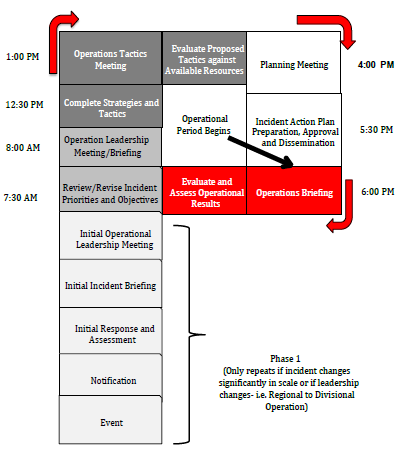
Lessons Learned
I learned that some people ‘in charge’ (and not at the Red Cross, mind you) see their work as ‘fiefdoms’. I was in the main event area in Philly one day, and ran into a New Jersey official I knew who was very shocked to see me in Philly. I think he thought he was in charge of everything.
I learned that there are some really, really good planners – as in incident action planners via ICS in other Regions of the Red Cross. We worked together as a team, each covering a ‘district’ (mine was all of New Jersey). If you understand Area Command, this was that.
I learned that Red Cross radio operators can “Jerry-rig” disparate communications systems together and make just about anything work.
I learned a lot about crowd movements, crowd types, and crowd safety. SS and I studied big events worldwide, including the annual Hajj to Mecca. We knew the potential for a consequence management incident associated with crowd problems could occur. There were also significant concerns – brought up by us – about people with disabilities and functional needs who might be walking from Camden across the Ben Franklin bridge. Heat Exhaustion was a concern, too. SS led the NJ side for operations and coordinated with me while I was imbedded at the DOC in Philly.
I learned that a no-hot water shower from a Salvation Army shower trailer is not fun at all. Especially three days in a row.
I learned that donated food – to Red Crossers – is very filling, very equitable, and unfortunately most times very bland – except on the days when Wawa was delivered. Still, no real complaints from me.
 |
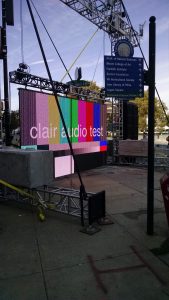 |
 |
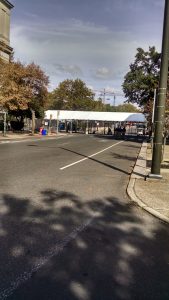 |
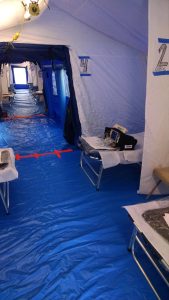 |
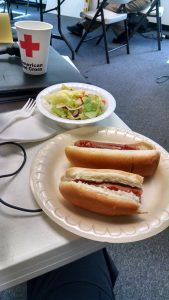 |
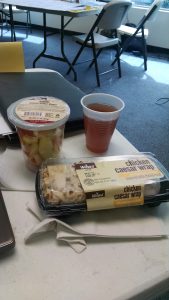 |
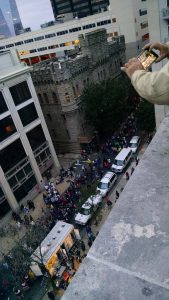 |
Lessons Applied
- I brought back with me a stronger network with the Southeastern Pennsylvania Red Cross Region, which later became part of the same Red Cross Division as New Jersey. As with the SuperBowl®, I am passing this intelligence on to the team working on the FIFA® World Cup events in 2026.
- I took that knowledge about crowds and events of scale, to our Red Cross Emergency! app folks, and they built a module about it – which was ready before this event. That was really cool – to provide preparedness messaging and best practices to the public when they need it the most. Unfortunately, that module is no longer available on the app (they used to have quite a bit of non-weather/natural threats but now only one – Power Outages), and will probably not get revamped, as part of the FIFA® World Cup series. It is possible that many of those features are part of an existing FIFA® Fan Experience mobile app, but that needs to be explored by someone else.
- And we continue to support each other across nearby – especially adjacent – Regions. This is quite common in Emergency Management. More community, less fiefdom. For those outside of the Red Cross, but still in Emergency Management, think of the Emergency Management Assistance Compact (EMAC). Being from New Jersey, I have both taken and given Red Cross training in Philly. Same for New York City. Three Regions, one team.
Incident Command System
Red Cross Disaster Operations Center - like an EOC.
Emergency Management Assistance Compact
